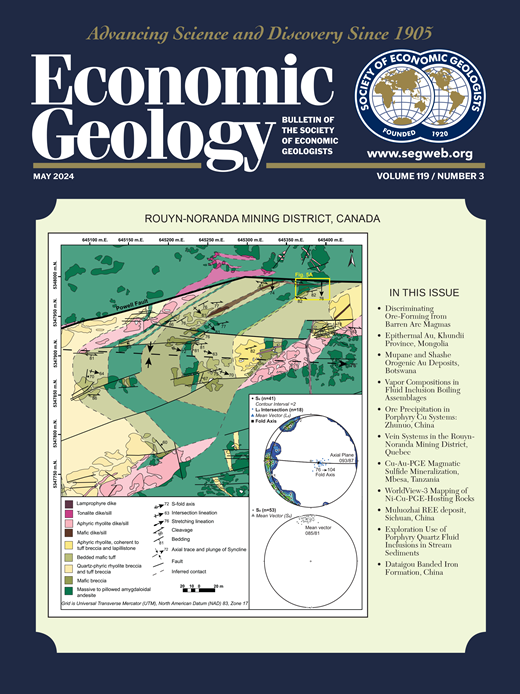The Structural Setting and Controls of Giant Lithium Pegmatite Deposits in the Archean Pilbara Craton, Western Australia
IF 4.9
1区 地球科学
Q1 GEOCHEMISTRY & GEOPHYSICS
引用次数: 0
Abstract
The giant lithium pegmatite deposits of the Archean Pilbara craton in Western Australia are located within the Turner River district, where they are associated with D4 structures and granitic intrusions of the Split Rock Supersuite, all of which are an expression of the final phase of orogenic activity in the granite-greenstone nucleus of the craton between 2.89 and 2.82 Ga. Progression of the D4 orogenic event involved early D4a wrench faulting, followed by emplacement of the granitic intrusions, and finally onset of D4b ductile shear zone deformation and the formation of the lithium pegmatite deposits. The giant deposits at Pilgangoora and Wodgina comprise vertically stacked sets of lithium pegmatite intrusions that were emplaced episodically during ductile fracturing, at lower amphibolite facies, within strained supracrustal wall rocks in D4b shear zones. Closely spaced D4a oblique faults are a feature of the deposit settings and, although they are an expression of earlier brittle deformation, an important role is recognized for these structures as passive attractors of coaxial strain during D4b shear zone deformation. The coaxial strain manifested as constriction and vertical extrusion in the deposit settings, and this is unique within the broader D4b shear zone array, which mostly expresses noncoaxial strain in the form of oblique extrusion. Together, the partitions of vertical and oblique extrusion are considered the product of regional transpression. Migration of low-viscosity melts that formed the lithium pegmatite intrusions was clearly favored within the partitions of D4b coaxial strain. This is attributed to the faster rates at which coaxial strains accumulate, which enhanced the potential for melt migration and intrusion emplacement, most likely through a combination of intergranular percolation and ductile fracturing. The convergence of D4a faults and D4b shear zones, as well as the association of such with lithium pegmatite intrusions, is an important criterium for exploration targeting. The structural disruption arising from D4a faults is perhaps the most distinctive feature expressed in satellite and airborne magnetic images, and therefore mapping, sampling, and/or drilling should focus within regions of overlap between shear zones and fault disruption.西澳大利亚皮尔巴拉克拉通太古宙巨型锂伟晶岩矿床的构造背景及控制因素
西澳大利亚太古代皮尔巴拉克拉通的巨型锂伟晶岩矿床位于特纳河地区,与该地区的D4构造和裂岩超套的花岗质侵入岩有关,是2.89 - 2.82 Ga之间克拉通花岗绿岩核造山活动最后阶段的表现。D4造山事件的演化过程为早期D4a扳手断裂,随后花岗岩侵入侵入,最后D4b韧性剪切带开始变形,形成锂伟晶岩矿床。Pilgangoora和Wodgina的巨型矿床由垂直堆积的锂伟晶岩侵入体组成,这些侵入体是在韧性压裂期间,在D4b剪切带的下角闪岩相中,在应变的壳上围岩中偶然形成的。紧密分布的D4a斜断层是沉积环境的一个特征,虽然它们是早期脆性变形的表现,但在D4b剪切带变形过程中,这些构造作为同轴应变的被动吸引子发挥了重要作用。在沉积环境中,共轴应变表现为收缩和垂直挤压,这在更广泛的D4b剪切带阵列中是独特的,D4b剪切带阵列主要以斜挤压形式表现非共轴应变。垂直和斜向挤压的分区被认为是区域挤压的产物。形成锂伟晶岩侵入体的低粘度熔体在D4b共轴应变分区内明显有利于迁移。这是由于同轴应变积累的速度更快,这增加了熔体迁移和侵入侵入的可能性,很可能是通过粒间渗透和韧性压裂的结合。D4a断裂与D4b剪切带的汇聚及其与锂伟晶岩侵入体的关联,是确定找矿目标的重要依据。D4a断层引起的构造破坏可能是卫星和航空磁图像中最显著的特征,因此测绘、采样和/或钻探应集中在剪切带和断层破坏之间的重叠区域。
本文章由计算机程序翻译,如有差异,请以英文原文为准。
求助全文
约1分钟内获得全文
求助全文
来源期刊

Economic Geology
地学-地球化学与地球物理
CiteScore
10.00
自引率
6.90%
发文量
120
审稿时长
6 months
期刊介绍:
The journal, now published semi-quarterly, was first published in 1905 by the Economic Geology Publishing Company (PUBCO), a not-for-profit company established for the purpose of publishing a periodical devoted to economic geology. On the founding of SEG in 1920, a cooperative arrangement between PUBCO and SEG made the journal the official organ of the Society, and PUBCO agreed to carry the Society''s name on the front cover under the heading "Bulletin of the Society of Economic Geologists". PUBCO and SEG continued to operate as cooperating but separate entities until 2001, when the Board of Directors of PUBCO and the Council of SEG, by unanimous consent, approved a formal agreement of merger. The former activities of the PUBCO Board of Directors are now carried out by a Publications Board, a new self-governing unit within SEG.
 求助内容:
求助内容: 应助结果提醒方式:
应助结果提醒方式:


